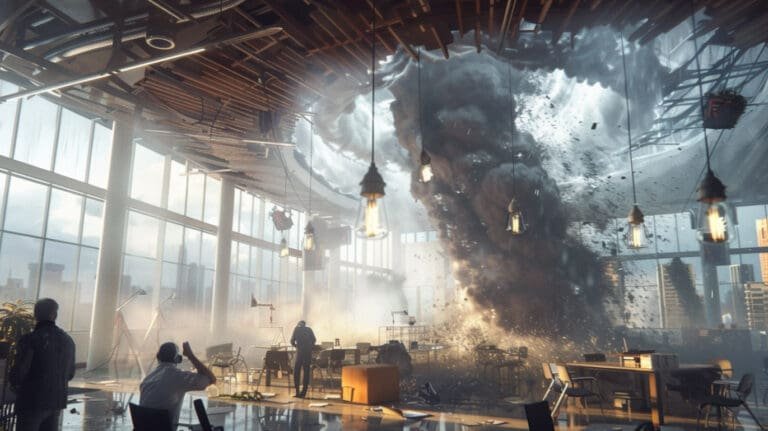Why an “Anchored Leader” is the Most Critical Role in a Visionary-Led Company
It’s Monday morning. Your team has a clear set of priorities for the week, meticulously planned and aligned. Then, the meeting with your founder begins. They are sparkling with brilliance, fresh from a weekend of inspiration, and they present a new, game-changing idea that is both exciting and completely derails every plan you just made.
If that scenario feels deeply familiar, you are not alone.
In the ecosystem of a growing, visionary-led company, there are often two key players: The visionary CEO is the beautiful, powerful hot air balloon, and you, the operational leader, are the indispensable anchor and ground crew. Understanding this dynamic isn’t just a helpful analogy – it’s the key to your success and your sanity.
This is your guide to understanding that relationship and embracing your most important identity: the Anchored Leader.
The Paradox of the Brilliant “Hot Air Balloon”
Let’s be clear: the visionary leader is the engine of your company’s growth. They see the future, connect disparate concepts, and operate with an infectious energy that inspires everyone. This ability to generate a constant stream of ideas, what I call the “idea tornado,” is their superpower and is often fueled by the unique wiring of a creative or ADHD-informed mind.
But a balloon without a ground crew is an accident waiting to happen. Untethered, that brilliant energy can create chaos. Priorities shift like the wind, the team is left with whiplash from constant context-switching, and valuable resources are spent on initiatives that are never fully completed.
The Critical, Often Unseen, Role of the Anchor
This is where you come in. Your role as the operational leader – the COO, Integrator, or second-in-command – is not to be the brakes that stop the balloon from rising. Your job is to be the anchor and the ground crew that makes a successful flight possible.
You aren’t just a “doer” of tasks. You are the one who ensures there’s a flight plan (a strategy), checks the fuel (the budget and resources), manages the payload (the team’s capacity), and plots a course for a safe and intentional landing (achieving the company’s goals). You provide the ballast, the structure, and the direction that makes the entire journey purposeful.

Three Myths About Being an Anchor in a Visionary and Integrator Relationship
Myth #1: The Anchor is just the “No” person.
Reality: A great anchor rarely says “no.” Instead, they say, “Yes, and…” or “That’s a brilliant idea. Let’s put it in our ‘Idea Dock’ to explore fully in our next quarterly planning session.” They redirect energy, they don’t block it.
Myth #2: Anchoring means slow and bureaucratic.
Reality: Anchoring is about creating clarity, which creates speed. When the team knows the priorities and has simple systems to follow, they can execute much faster than when they are constantly whipsawed by changing directions.
Myth #3: The Visionary is more important than the Anchor.
Reality: They are equally critical. The balloon cannot fly to the right destination without the ground crew, and the ground crew has no purpose without the balloon. It is a partnership of equals with different, complementary skills.
The Danger of a Frayed Rope: When the Partnership Fails
The partnership between the Anchor and the Balloon is the most critical relationship in the business. When it’s unhealthy, the entire organization feels it. There are two common failure modes:
- The Anchor Tries to Be a Balloon: The operational leader, feeling their value is only in ideas, competes with the visionary. This leads to friction, confusion, and a power struggle at the top.
- The Anchor is Too Heavy: The operational leader, fearing chaos, uses rigid processes and bureaucracy to say “no” to everything. This stifles the creative spark, frustrates the visionary, and kills team morale.
This looks like the COO who responds to every new idea with ‘We can’t do that, it’s not in the budget’ or ‘We need to form a committee to study that,’ effectively pouring water on the visionary’s creative fire.
Either path leads to the same destination: a strained partnership, a burnt-out team, and a company that hits a growth ceiling, stuck in a cycle of brilliant starts and failed finishes.
What It Truly Means to Be an “Anchored Leader”
Becoming an Anchored Leader is an identity shift. It’s about understanding that your greatest value isn’t in doing all the things, but creating the environment where the right things get done effectively.
It means embodying these four key qualities:
1. You are a Stabilizing Force
You are the calm in the storm. By creating psychological safety and operational predictability, you give your team the confidence to innovate and perform at their best without fearing constant, jarring changes. Your consistency becomes a powerful asset that calms the entire organization.
2. You are a Strategic Filter
You evolve from an “order taker” into a true strategic partner. You learn to honor your CEO’s visionary ideas while skillfully filtering them through the lens of the company’s core strategy, capacity, and resources. You help differentiate between brilliant distractions and game-changing priorities.
3. You are a Systems Designer
You make the crucial mindset shift from a reactive “Fixer” to a proactive “Designer”. Your focus becomes building simple, robust Minimum Viable Systems (MVS) that create leverage and empower your team. You stop being the bottleneck and become the architect of your company’s scalable operating system.
The Anchor also provides value by building the simple, effective systems the business needs to scale. But, that can also require a process I call ‘untangling the spaghetti‘ to find the simplicity on the other side of complexity in the processes that are already in place.
4. You are a Model of Sustainability
You understand that burnout is not a badge of honor. By setting healthy boundaries and designing a personal operating system that preserves your energy, you lead with a calm confidence that becomes contagious. You prove that sustainable leadership is the only kind that wins in the long run.
Consider This Post: The Visionary and Integrator: 3 Conversations to Define Your Partnership – One of the first steps to becoming an anchored leader is to have the conversation with your strategic partner, your hot air balloon CEO.

Your First Step to Dropping Your Anchor
This transformation from reactive fixer to strategic leader doesn’t happen overnight. It begins with awareness.
This week, I invite you to observe your own leadership with curiosity. Ask yourself: in your key interactions, are you operating more as a “Fixer,” putting out fires? Or as an “Anchor,” providing stability? What is one small thing you could do tomorrow to provide more stability for your team or your CEO?
The partnership between a Visionary and an Anchor is what allows a company to both soar to incredible heights and navigate the inevitable storms. Embracing your role as the indispensable anchor is the most important work you will ever do.
Ready to Become The Anchored Leader Your Team Needs?
Understanding these concepts is the crucial first step. Putting them into practice amidst the daily chaos of your role is the real challenge.
If you’re ready to get personalized guidance on how to apply these principles to your unique partnership and build the systems your company needs, the best way to start is with a complimentary Clarity Call. It’s a no-pressure conversation to see if my 1-on-1 private coaching is the right fit to help you on your journey.







